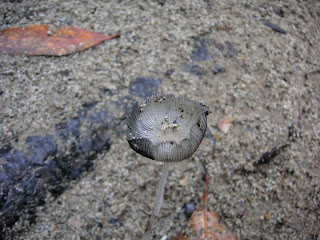Very cool! While I've seen plenty of hand-sized CA market squid (Loligo opalescens, aka Doryteuthis opalescens) offloaded from the squid boats and displayed in, well, the local fish markets, this is the first time I've seen a Humboldt squid alive (i.e., not jarred or dissected at Hopkins). There were two of these washed up on the beach, slowly flapping those triangle shaped fins. I would guess this one was a little over 2 feet in length, which apparently is less than half the size they can get in 2 years or less.
A scuba diver gently lifted them up and returned them to the water. Another diver told us these good-sized squid have been close to the shore for the past couple of days numbering in the hundreds. Then, yet, another diver proceeded to authoritatively tell some wild story about how these were "queens" and were the only ones that reproduced. Ha! I think there's quite a bit of myth surrounding squid, and for good reason.
Humboldt squid have only been seen with any regularity in Monterey Bay for the past 10-15 years since the big 1997-98 El Niño event. MBARI has been using their ROVs to video and record marine animals and have collected data on Humboldt squid. There are various guesses as to why they have been moving northward from their breeding grounds off the coast of Mexico. I'll have to read more about them in the coming days. What impressed me most about these molluscs were those mammalian-like eyes that seemed to convey thought and intelligence. Their colors were beautiful, too!
ps 11/02/12 - The Humboldt squid have made our local news at Monterey County Herald and KSBW with about 100 washing ashore near Hopkins on Tuesday. Both links contain videos.
ps 11/02/12 - The Humboldt squid have made our local news at Monterey County Herald and KSBW with about 100 washing ashore near Hopkins on Tuesday. Both links contain videos.




















